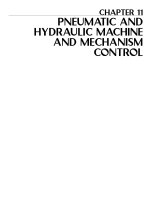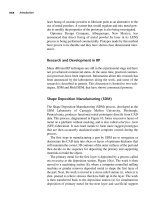brazing, soldering, adhesive bonding and mechanical fastening processes
Bạn đang xem bản rút gọn của tài liệu. Xem và tải ngay bản đầy đủ của tài liệu tại đây (2.61 MB, 130 trang )
Brazing, Soldering, Adhesive-
Brazing, Soldering, Adhesive-
Bonding, and Mechanical-
Bonding, and Mechanical-
Fastening Processes
Fastening Processes
Ir. Tri Prakosa, M. Eng.
Proses Manufaktur II, Januari 2010
1
Manufacturing, Engineering & Technology, Fifth Edition, by Serope Kalpakjian and Steven R. Schmid.
ISBN 0-13-148965-8. © 2006 Pearson Education, Inc., Upper Saddle River, NJ. All rights reserved.
Brazed and Soldered Parts
Brazed and Soldered Parts
Source: Courtesy of Edison Welding Institute.
(a) Resistance brazed light bulb filament
(b) brazed radiator heat exchangers
(c) soldered circuit board
(d) brazed ring housing
(e) brazed heat exchanger.
Manufacturing, Engineering & Technology, Fifth Edition, by Serope Kalpakjian and Steven R. Schmid.
ISBN 0-13-148965-8. © 2006 Pearson Education, Inc., Upper Saddle River, NJ. All rights reserved.
Cobe Laboratories Blood Reservoir
Cobe Laboratories Blood Reservoir
The Cobe Laboratories blood reservoir. The
lid is bonded to the bowl with an airtight
adhesive joint and tongue-in-groove joint.
Source: Courtesy of Cobe Laboratories.
Introduction
Introduction
In almost all the joining processes described in
previous lectures, the metals to be joined were
heated to elevated temperatures by various
means to cause fusion or bonding at the joint.
But how to join materials that cannot withstand
high temperatures, such as electronic
components?
What if the parts to be joined are delicate or
intricate or are made of two or more materials
with very different characteristics, properties,
thicknesses, and cross-sections?
Institut Teknologi Bandung4
Introduction, con’t
Introduction, con’t
Today’s lecture first describes two joining
processes, brazing and soldering, which permit
lower temperatures than those required for
welding.
In both brazing and soldering, filler metals are
placed in or supplied to the joint.
They are then melted using an external source
of heat and, upon solidification, a strong joint
results.
Institut Teknologi Bandung5
Introduction, con’t
Introduction, con’t
Soldering temperatures are lower than those of
brazing, and the strength of a soldered joint is
not high.
Thus brazing and soldering are arbitrarily
distinguished by temperature.
Institut Teknologi Bandung6
Introduction, con’t
Introduction, con’t
This lecture also describes adhesive bonding
techniques.
The ancient method of joining parts with animal
glue, as is done in labeling, packaging, and
bookbinding, has now developed into an
important technology with wide applications in
aerospace and various other industries.
Institut Teknologi Bandung7
Introduction, con’t
Introduction, con’t
All the joints described so far are of a permanent
nature.
In many applications, there are situations where
joined parts have to be taken apart for
replacement, maintenance, repair, or adjustment.
How to take apart (separating), a product without
destroying the joint?
If we need joints that are truly nonpermanent but
are as strong as welded joints-the solution
obviously is to use mechanical means, such as
bolts, screws, nuts, and a variety of similar
fasteners.
Institut Teknologi Bandung8
Manufacturing, Engineering & Technology, Fifth Edition, by Serope Kalpakjian and Steven R. Schmid.
ISBN 0-13-148965-8. © 2006 Pearson Education, Inc., Upper Saddle River, NJ. All rights reserved.
Effect of Joint Clearance on Strength of
Effect of Joint Clearance on Strength of
Brazed Joints
Brazed Joints
The effect of joint clearance on tensile and shear strength of brazed joints. Note that
unlike tensile strength, shear strength continually decreases as the clearance
increases.
BRAZING
BRAZING
Institut Teknologi Bandung10
Brazing
Brazing
Brazing is a joining process in which a filler
metal is placed at or between the faying
surfaces to be joined, and the temperature is
raised to melt the filler metal but not the
workpieces, (Figure a).
Institut Teknologi Bandung11
(a) Operasi Brazing
Brazing
Brazing
The molten metal fills the closely fitting space by
capillary action.
Upon cooling and solidification of the filler metal,
a strong joint is obtained.
Brazing comes from the word brass, an archaic
word meaning to harden, and was first used as
far back as 3000-2000 B.C.
Institut Teknologi Bandung12
Brazing
Brazing
There are two types of brazing processes:
a. that was previously described, and
b. braze welding (Figure b), in which the filler metal is
deposited at the joint with a technique similar to
oxyfuel gas welding.
Institut Teknologi Bandung13
(b) Braze
welding
Brazing
Brazing
Filler metals used for brazing melt above 450 °C
(840 °F).
The temperatures employed in brazing are
below the melting point (solidus temperature) of
the metals to be joined.
Thus this process is unlike liquid-state welding
processes in which the workpieces must melt in
the weld area for fusion to occur.
Problems associated with heat affected zones,
warping, and residual stresses are therefore
reduced in brazing.
Institut Teknologi Bandung14
Brazing
Brazing
The strength of the brazed joint depends on:
a. joint design and
b. the adhesion at the interfaces of the workpiece and
filler metal.
Consequently, the surfaces to be brazed should
be chemically or mechanically cleaned to
ensure full capillary action; hence the use of a
flux is important.
Institut Teknologi Bandung15
Filler metals
Filler metals
Several filler metals (braze metals) are available
and have a range of brazing temperatures, see
the Table below:
Institut Teknologi Bandung16
Filler metals
Filler metals
Variety of filler shapes: wire, rings, shims, and
filings.
The choice of filler metal and its composition are
important in order to avoid embrittlement of the
joint (by grain boundary penetration of liquid
metal), formation of brittle intermetallic
compounds at the joint, and galvanic corrosion
in the joint.
Filler metals for brazing, unlike other welding
operations, generally have significantly different
compositions than the metals to be joined.
Institut Teknologi Bandung17
Filler metals
Filler metals
Because of diffusion between the filler metal
and the base metal, mechanical and
metallurgical properties of joints can change in
subsequent processing or during the service life
of brazed components.
For example, when titanium is brazed with pure
tin filler metal, it is possible for the tin to
completely diffuse into the titanium base metal
by subsequent aging or heat treatment.
When that happens, the joint no longer exists.
Institut Teknologi Bandung18
Fluxes
Fluxes
The use of a flux is essential in brazing in order
to prevent oxidation and to remove oxide films
from workpiece surfaces.
Brazing fluxes are generally made of borax,
boric acid, borates, fluorides and chlorides.
Wetting agents may also be added to improve
both the wetting characteristics of the molten
filler metal and capillary action.
Surfaces to be brazed must be clean and free
from rust, oil, and other contaminants.
Institut Teknologi Bandung19
Fluxes
Fluxes
Clean surfaces are essential to obtain the
proper wetting and spreading characteristics of
the molten filler metal in the joint and maximum
bond strength.
Sand blasting may also be used to improve
surface finish of faying surfaces.
Because they are corrosive, fluxes should be
removed after brazing (usually by washing with
hot water).
Institut Teknologi Bandung20
Brazing methods
Brazing methods
Torch brazing.
Torch brazing.
The heat source in torch brazing (TB) is oxyfuel
gas with a carburizing flame.
Brazing is performed by first heating the joint
with the torch, then depositing the brazing rod or
wire in the joint.
Suitable part thicknesses are usually in the
range of 0.25-6 mm (0.01-0.25 in.).
More than one torch may be used in this
process.
Institut Teknologi Bandung21
Carburizing Flame
O
2
< oxyacethilene
Jenis-jenis nyala las oxyfuel
Jenis-jenis nyala las oxyfuel
Institut Teknologi Bandung22
a) Neutral Flame
acetylene : oxygen
1: 1
b) Oxidizing Flame
Kelebihan Oksigen
c) Carburizing Flame
Kekurangan Oksigen
Brazing methods
Brazing methods
Torch brazing.
Torch brazing.
Although it can be automated as a production
process, torch brazing is difficult to control and
requires skilled labor.
This process can also be used for repair work.
The basic equipment for manual brazing costs
about $300 but can run more than $50,000 for
automated systems.
Institut Teknologi Bandung23
Brazing methods
Brazing methods
Furnace brazing.
Furnace brazing.
As the name suggests, furnace brazing (FB) is
carried out in a furnace.
The parts are re-cleaned and re-loaded with
brazing metal in appropriate configurations
before being placed in the furnace.
Institut Teknologi Bandung24
Contoh brazing yang dilakukan di dalam tungku(furnace brazing): (a) sebelum,
(b) sesudah. Perhatikan bahwa logam pengisi berupa kawat.
Brazing methods
Brazing methods
Furnace brazing.
Furnace brazing.
Furnaces may be batch type for complex
shapes or continuous type for high production
runs, especially for small parts with simple joint
designs.
Vacuum furnaces or neutral atmospheres are
used for metals that react with the environment.
This process is similar to using shielding gas in
welding operations.
Institut Teknologi Bandung25









